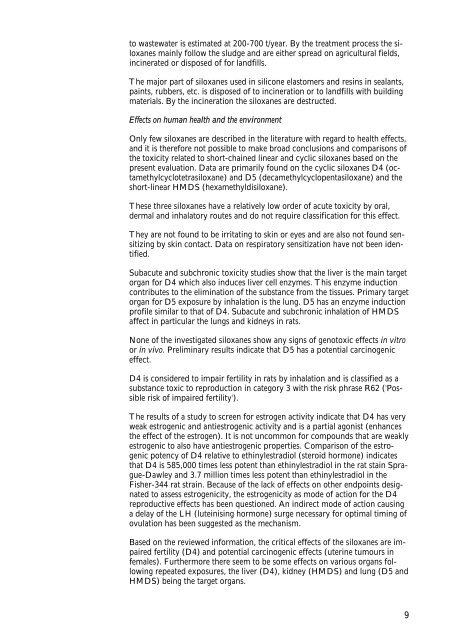No. 1031 - Miljøstyrelsen
No. 1031 - Miljøstyrelsen
No. 1031 - Miljøstyrelsen
You also want an ePaper? Increase the reach of your titles
YUMPU automatically turns print PDFs into web optimized ePapers that Google loves.
to wastewater is estimated at 200-700 t/year. By the treatment process the siloxanes<br />
mainly follow the sludge and are either spread on agricultural fields,<br />
incinerated or disposed of for landfills.<br />
The major part of siloxanes used in silicone elastomers and resins in sealants,<br />
paints, rubbers, etc. is disposed of to incineration or to landfills with building<br />
materials. By the incineration the siloxanes are destructed.<br />
Effects on human health and the environment<br />
Only few siloxanes are described in the literature with regard to health effects,<br />
and it is therefore not possible to make broad conclusions and comparisons of<br />
the toxicity related to short-chained linear and cyclic siloxanes based on the<br />
present evaluation. Data are primarily found on the cyclic siloxanes D4 (octamethylcyclotetrasiloxane)<br />
and D5 (decamethylcyclopentasiloxane) and the<br />
short-linear HMDS (hexamethyldisiloxane).<br />
These three siloxanes have a relatively low order of acute toxicity by oral,<br />
dermal and inhalatory routes and do not require classification for this effect.<br />
They are not found to be irritating to skin or eyes and are also not found sensitizing<br />
by skin contact. Data on respiratory sensitization have not been identified.<br />
Subacute and subchronic toxicity studies show that the liver is the main target<br />
organ for D4 which also induces liver cell enzymes. This enzyme induction<br />
contributes to the elimination of the substance from the tissues. Primary target<br />
organ for D5 exposure by inhalation is the lung. D5 has an enzyme induction<br />
profile similar to that of D4. Subacute and subchronic inhalation of HMDS<br />
affect in particular the lungs and kidneys in rats.<br />
<strong>No</strong>ne of the investigated siloxanes show any signs of genotoxic effects in vitro<br />
or in vivo. Preliminary results indicate that D5 has a potential carcinogenic<br />
effect.<br />
D4 is considered to impair fertility in rats by inhalation and is classified as a<br />
substance toxic to reproduction in category 3 with the risk phrase R62 ('Possible<br />
risk of impaired fertility').<br />
The results of a study to screen for estrogen activity indicate that D4 has very<br />
weak estrogenic and antiestrogenic activity and is a partial agonist (enhances<br />
the effect of the estrogen). It is not uncommon for compounds that are weakly<br />
estrogenic to also have antiestrogenic properties. Comparison of the estrogenic<br />
potency of D4 relative to ethinylestradiol (steroid hormone) indicates<br />
that D4 is 585,000 times less potent than ethinylestradiol in the rat stain Sprague-Dawley<br />
and 3.7 million times less potent than ethinylestradiol in the<br />
Fisher-344 rat strain. Because of the lack of effects on other endpoints designated<br />
to assess estrogenicity, the estrogenicity as mode of action for the D4<br />
reproductive effects has been questioned. An indirect mode of action causing<br />
a delay of the LH (luteinising hormone) surge necessary for optimal timing of<br />
ovulation has been suggested as the mechanism.<br />
Based on the reviewed information, the critical effects of the siloxanes are impaired<br />
fertility (D4) and potential carcinogenic effects (uterine tumours in<br />
females). Furthermore there seem to be some effects on various organs following<br />
repeated exposures, the liver (D4), kidney (HMDS) and lung (D5 and<br />
HMDS) being the target organs.<br />
9

















